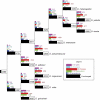Evolution at the subgene level: domain rearrangements in the Drosophila phylogeny
- PMID: 21900599
- PMCID: PMC3258039
- DOI: 10.1093/molbev/msr222
Evolution at the subgene level: domain rearrangements in the Drosophila phylogeny
Abstract
Although the possibility of gene evolution by domain rearrangements has long been appreciated, current methods for reconstructing and systematically analyzing gene family evolution are limited to events such as duplication, loss, and sometimes, horizontal transfer. However, within the Drosophila clade, we find domain rearrangements occur in 35.9% of gene families, and thus, any comprehensive study of gene evolution in these species will need to account for such events. Here, we present a new computational model and algorithm for reconstructing gene evolution at the domain level. We develop a method for detecting homologous domains between genes and present a phylogenetic algorithm for reconstructing maximum parsimony evolutionary histories that include domain generation, duplication, loss, merge (fusion), and split (fission) events. Using this method, we find that genes involved in fusion and fission are enriched in signaling and development, suggesting that domain rearrangements and reuse may be crucial in these processes. We also find that fusion is more abundant than fission, and that fusion and fission events occur predominantly alongside duplication, with 92.5% and 34.3% of fusion and fission events retaining ancestral architectures in the duplicated copies. We provide a catalog of ∼9,000 genes that undergo domain rearrangement across nine sequenced species, along with possible mechanisms for their formation. These results dramatically expand on evolution at the subgene level and offer several insights into how new genes and functions arise between species.
Figures









Similar articles
-
Ab Initio Construction and Evolutionary Analysis of Protein-Coding Gene Families with Partially Homologous Relationships: Closely Related Drosophila Genomes as a Case Study.Genome Biol Evol. 2020 Mar 1;12(3):185-202. doi: 10.1093/gbe/evaa041. Genome Biol Evol. 2020. PMID: 32108239 Free PMC article.
-
Evolution of double MutT/Nudix domain-containing proteins: similar domain architectures from independent gene duplication-fusion events.J Genet Genomics. 2009 Oct;36(10):603-10. doi: 10.1016/S1673-8527(08)60152-6. J Genet Genomics. 2009. PMID: 19840758
-
Modeling the evolution of protein domain architectures using maximum parsimony.J Mol Biol. 2007 Feb 9;366(1):307-15. doi: 10.1016/j.jmb.2006.11.017. Epub 2006 Nov 10. J Mol Biol. 2007. PMID: 17166515 Free PMC article.
-
Models, algorithms and programs for phylogeny reconciliation.Brief Bioinform. 2011 Sep;12(5):392-400. doi: 10.1093/bib/bbr045. Brief Bioinform. 2011. PMID: 21949266 Review.
-
Quantification and functional analysis of modular protein evolution in a dense phylogenetic tree.Biochim Biophys Acta. 2013 May;1834(5):898-907. doi: 10.1016/j.bbapap.2013.01.007. Epub 2013 Feb 1. Biochim Biophys Acta. 2013. PMID: 23376183 Review.
Cited by
-
DeCoSTAR: Reconstructing the Ancestral Organization of Genes or Genomes Using Reconciled Phylogenies.Genome Biol Evol. 2017 May 1;9(5):1312-1319. doi: 10.1093/gbe/evx069. Genome Biol Evol. 2017. PMID: 28402423 Free PMC article.
-
Alien Domains Shaped the Modular Structure of Plant NLR Proteins.Genome Biol Evol. 2019 Dec 1;11(12):3466-3477. doi: 10.1093/gbe/evz248. Genome Biol Evol. 2019. PMID: 31730154 Free PMC article.
-
Improved inference of tandem domain duplications.Bioinformatics. 2021 Jul 12;37(Suppl_1):i133-i141. doi: 10.1093/bioinformatics/btab329. Bioinformatics. 2021. PMID: 34252920 Free PMC article.
-
Phylogenetic reconciliation.PLoS Comput Biol. 2022 Nov 3;18(11):e1010621. doi: 10.1371/journal.pcbi.1010621. eCollection 2022 Nov. PLoS Comput Biol. 2022. PMID: 36327227 Free PMC article. No abstract available.
-
Probabilistic modeling of the evolution of gene synteny within reconciled phylogenies.BMC Bioinformatics. 2015;16 Suppl 14(Suppl 14):S5. doi: 10.1186/1471-2105-16-S14-S5. Epub 2015 Oct 2. BMC Bioinformatics. 2015. PMID: 26452018 Free PMC article.
References
-
- Apic G, Gough J, Teichmann SA. An insight into domain combinations. Bioinformatics. 2001;17:S83–S89. - PubMed
-
- Apic G, Huber W, Teichmann SA. Multi-domain protein families and domain pairs: comparison with known structures and a random model of domain recombination. J Struct Funct Genomics. 2003;4:67–78. - PubMed
-
- Arvestad L, Lagergren J, Sennblad B. The gene evolution model and computing its associated probabilities. JACM. 2009;56:1–44.
Publication types
MeSH terms
Substances
Grants and funding
LinkOut - more resources
Full Text Sources
Molecular Biology Databases

